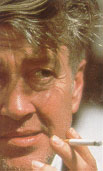Creative Screenwriting, November/December 2001
Lynch On Lynch
Reviewed by Dan Czajkowski
 David Lynch's bucolic The Straight Story left fans
and critics across the nation wondering what had
become of the controversial creator of Twin
Peaks. The recent intrigue surrounding Mulholland Drive gave hope that Lynch would once
again haunt our weekly network programming
with his dark and uncanny brand of storytelling.
just as the negative reception of Fire Walk with
Me raised questions about the best medium for
Lynch's vision, Mulholland Drive's translation
into film now promises to elicit an equivalent
number of theories vying to define the director.
David Lynch's bucolic The Straight Story left fans
and critics across the nation wondering what had
become of the controversial creator of Twin
Peaks. The recent intrigue surrounding Mulholland Drive gave hope that Lynch would once
again haunt our weekly network programming
with his dark and uncanny brand of storytelling.
just as the negative reception of Fire Walk with
Me raised questions about the best medium for
Lynch's vision, Mulholland Drive's translation
into film now promises to elicit an equivalent
number of theories vying to define the director.
Lynch on Lynch provides a well-thought-out
series of terms and concepts in which to frame
this discussion, exploring trends in Lynch's
repertoire common to both media. Rodley's
rather wide-ranging interviews with the director are commendable for their attempt to provide some continuity between film and
television through a well-defined set of concepts
and filmic techniques. Even when Lynch can't,
or won't, supply a definitive answer to a Rodley's question, the interview has brought the
reader's attention to a productive set of
inquiries surrounding the director's techniques, public reception, and influence on TV
and film audiences.
Rodley begins the book by offering David
Lynch as quintessentially "American," and he
makes this particular line of questioning work
for him throughout the book While a quick look
at Lynch's most recent film, The Straight Story,
may corroborate that impression in a topical
sort of way (a family drama in America's heartland), Rodley does a lot more with the notion:
he develops the concept of the 'American" director through a discussion of specific techniques
in Lynch's films, including film location, use of
narrative, and how Lynch's films stand in contrast to European filmic influences.
Perhaps the most consistent and successful
fine of questioning involves Lynch's use of sound.
Rodley lays the groundwork for this aspect of
Lynch's work
quite early,
beginning, oddly enough, with
his interest in
painting (and a interesting parallel to the painter
Francis Bacon). Lynch's painting integrates
words as figures and textures, alienating sound
from its natural, everyday context. This assertion
allows Rodley to make some headway in his
characterization of Lynch as a purveyor of the
"uncanny" (as a general indication of Lynch's
relation to narrative in film). By tracing the use
of sound throughout the lesser known The
Grandmother and cult classics like Eraserhead,
Rodley draws some strong connections using
sound as its center.
Of course, a particularly poignant topic of
conversation oven the recent Mulholland Drive
intrigue, is Lynch's television work which Rodley explores thoroughly in the form of Twin
Peaks. Rodley broaches the conversation by
focusing on Lynch's use of sound in Twin
Peaks, dovetailing nicely with previous discussions on film. In Rodley's words, Lynch's work
in television allowed him to "indulge in his affection for speech rhythms and the particular qualities of the performers' voices." This notion is
all the more interesting when trying to address
the apparent chasm between early works such
as Eraserhead and the seemingly uncharacteristic The Straight Story.
As with each chapter, Rodley introduces his
discussions with an opening critical frame, and
then proceeds to more pointed questions.
Although Rodley is quite adept at pushing Lynch
beyond generalizations, he can't be blamed for
the director's occasional refusal to respond. Trying to ascertain Lynch's sense of his impact on
television, Rodley suggests that Twin Peaks
"helped to create an appetite" for the X-Files,
Wild Palms, and similarly "dark" material.
Lynch's response? "Maybe so."
Back to the David Lynch articles page.
 David Lynch's bucolic The Straight Story left fans
and critics across the nation wondering what had
become of the controversial creator of Twin
Peaks. The recent intrigue surrounding Mulholland Drive gave hope that Lynch would once
again haunt our weekly network programming
with his dark and uncanny brand of storytelling.
just as the negative reception of Fire Walk with
Me raised questions about the best medium for
Lynch's vision, Mulholland Drive's translation
into film now promises to elicit an equivalent
number of theories vying to define the director.
David Lynch's bucolic The Straight Story left fans
and critics across the nation wondering what had
become of the controversial creator of Twin
Peaks. The recent intrigue surrounding Mulholland Drive gave hope that Lynch would once
again haunt our weekly network programming
with his dark and uncanny brand of storytelling.
just as the negative reception of Fire Walk with
Me raised questions about the best medium for
Lynch's vision, Mulholland Drive's translation
into film now promises to elicit an equivalent
number of theories vying to define the director.